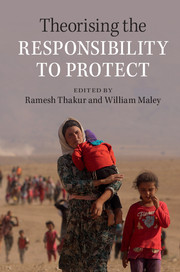Book contents
- Frontmatter
- Contents
- List of figures
- Notes on contributors
- Part I Context
- Part II The Responsibility to Protect, normative theory and global governance
- 5 The Responsibility to Protect and world order
- 6 International law and the Responsibility to Protect
- 7 The Responsibility to Protect, multilateralism and international legitimacy
- 8 Global governance and the Responsibility to Protect
- 9 International law, the Responsibility to Protect and international crises
- 10 The Responsibility to Protect and the just war tradition
- 11 War is not the answer: the Responsibility to Protect and military intervention
- Part III The Responsibility to Protect and international social purposes
- Index
11 - War is not the answer: the Responsibility to Protect and military intervention
from Part II - The Responsibility to Protect, normative theory and global governance
Published online by Cambridge University Press: 05 August 2015
- Frontmatter
- Contents
- List of figures
- Notes on contributors
- Part I Context
- Part II The Responsibility to Protect, normative theory and global governance
- 5 The Responsibility to Protect and world order
- 6 International law and the Responsibility to Protect
- 7 The Responsibility to Protect, multilateralism and international legitimacy
- 8 Global governance and the Responsibility to Protect
- 9 International law, the Responsibility to Protect and international crises
- 10 The Responsibility to Protect and the just war tradition
- 11 War is not the answer: the Responsibility to Protect and military intervention
- Part III The Responsibility to Protect and international social purposes
- Index
Summary
The past is never dead. It's not even past.
William FaulknerFrom 2005 to 2011, the bulk of scholarly commentary on the Responsibility to Protect (R2P) doctrine agreed that following the 2005 UN General Assembly World Summit, military intervention was no longer a central component. Indeed, some interventionists lamented that R2P had become ‘R2P-lite’; that is, stripped of its coercive authority. R2P supporters, however, maintained that through jettisoning the language of ‘humanitarian intervention’, featuring ‘sovereignty as responsibility’, prioritising prevention, and imposing tight constraints, R2P made military intervention broadly acceptable as a hard edge to be used rarely. They were not pleased, then, when Nicaraguan Foreign Minister Miguel d'Escoto Brockmann, as president of the General Assembly, convened a debate on R2P in 2009 and questioned the military intervention component. Special Adviser to the UN secretary-general, Edward Luck, cautioned the Assembly not to ‘turn back the clock, to divide the membership’ by resurrecting ‘the old caricature that RtoP is another word for military intervention’. To supporters' relief, despite airing multiple concerns, the Assembly reaffirmed the 2005 consensus.
Since the UN Security Council's invoking of R2P in 2011 to justify the US–NATO (North Atlantic Treaty Organization) military operation against Muammar Gaddafi's forces in Libya, the consensus has frayed. This action brought home that military intervention is a salient and consequential feature of R2P. Moreover, the manner of intervention – where diplomatic overtures were rejected and the goal morphed into regime change – and the disastrous aftermath – with Libya turning far more deadly and unstable – undermined the claim that R2P enables effective, well-regulated operations. Consequently, support in the global South has shrunk measurably. As stated by Brazil's UN Ambassador, there is ‘a growing perception that the concept of the Responsibility to Protect might be misused for purposes other than protecting civilians’.
R2P defenders still prefer to keep the discussion on how to improve implementation. However, precluding a more fundamental debate is a poor idea. To begin with, there continues to be significant controversy on whether to give normative validation to use force for ostensibly humanitarian reasons. In the past, delegations with trepidations put off a confrontation on the apparent belief that the 2005 World Summit formulation had bracketed military intervention to a hypothetical possibility to be worked out in future discussions.
- Type
- Chapter
- Information
- Theorising the Responsibility to Protect , pp. 200 - 220Publisher: Cambridge University PressPrint publication year: 2015
- 3
- Cited by



